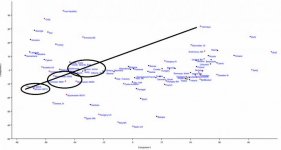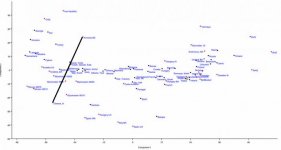davef
Princess
maybe nat-geno old tests for phoenician ( north levant admixture )
Ancient maritime traders of the Mediterranean may have left behind a large genetic footprint in the region, where 1 in 17 men still harbors Phoenician DNA, according to a new study.
The findings could fill a gap in the history of the Phoenician civilization, which originated two to three thousand years ago in the eastern Mediterranean—in what is now Lebanon and Syria—and included prominent traders, according to Chris Tyler-Smith, lead author and associate researcher at National Geographic Society's Genographic Project. (The National Geographic Society owns National Geographic News.)
Genetics gives an alluring clue. The Lebanese, the descendants of the Phoenicians, cluster with the Northern Middle East (along with Kurds and Armenians). This is significant because both Kurds and Armenians are Indo-Iranian groups—nations that speak Indo-European languages (not Semitic ones).
revealed that north-levant peoples came from the north of the zargos mountains and the south-levant came from negrev/North-east africa .............the admixture "war" happened in modern south lebanon
It fits with the late bronze age hittite empire of the levant
Cool post, Sile. Phoenicians are interesting...I read from a cracked article that they've been recorded by various monarchs throughout the Middle East and Southern Europe....yet no one could figure out where they came from or who they even were to begin with. They were a real mystery!!






